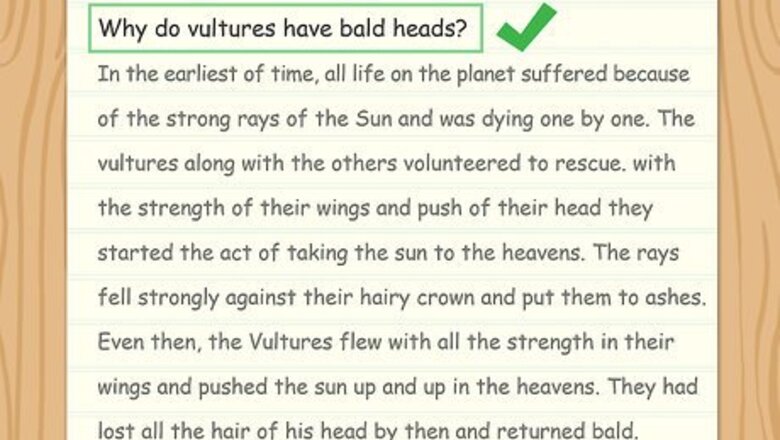
views
Brainstorming Ideas
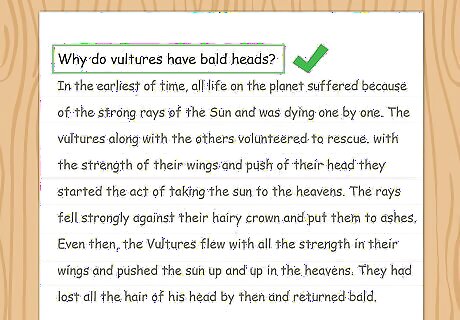
Decide what your myth explains. Many myths explain why an event occurs, how something was first created, or why people should act a certain way. Here are some examples from real myths: Why does the moon wax and wane? Why do vultures have bald heads? Why do people prepare and eat foods in certain ways, or on certain holidays?
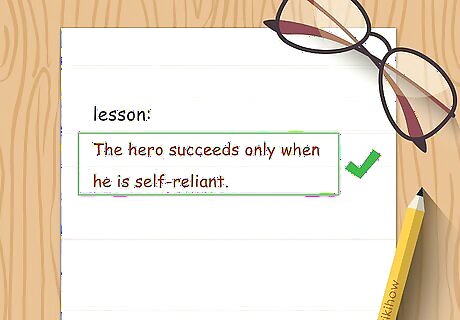
Think about including a lesson. Some myths explain why people should or shouldn't behave in certain ways. This can be a straightforward lesson with a moral at the end, but more often, the reader picks up on the lesson by seeing good actions rewarded, and evil or foolish actions punished. Here are a few ideas that you could use as the main focus of your work, if you like this approach: The hero succeeds only when he follows the advice of elders or gods — or alternatively, only when he is self-reliant. The hero must be clever to succeed, solving problems in creative ways. Some myths even teach that luck can be more important than skill. It can be fun to hear about an "ordinary" person who gets rewarded, or entertaining to hear about a complete fool who somehow becomes king.
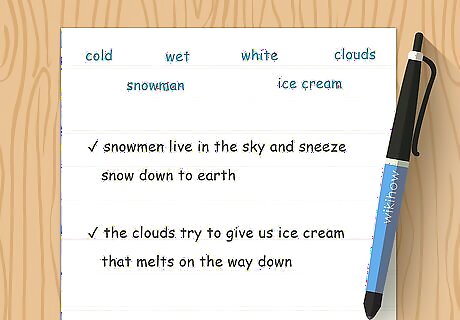
Turn your idea into something fantastical. Your myth can be silly or serious, but it should involve something that doesn't happen in the real world. For example, a volcano might erupt because giants underground left the barbecue on. A hero might be forced to learn to care about people after an evil serpent turns his family into trees. If you're having trouble coming up with a mythological explanation for the topic you chose, write down a list of words that remind you of snow. If you want to explain how snowstorms happen, write down "cold, wet, white, snowman, ice cream, clouds." Maybe snowmen live in the sky and sneeze snow down to earth, or maybe the clouds try to give us ice cream that melts on the way down.
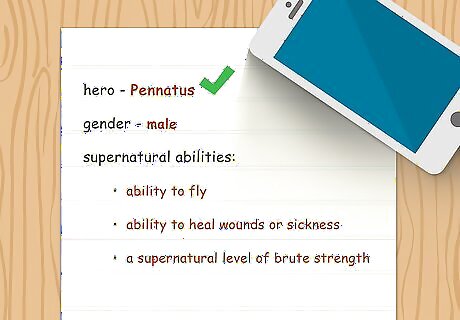
Create a hero. The hero of the story is usually someone impressive and admirable, although as mentioned above, you can write about an ordinary person instead. Think about these questions as you write down ideas for your hero: Is the hero super-strong, super-intelligent, or incredibly talented in one area? Some heroes have "superpowers" such as shooting a bow with perfect aim, or the ability to knock people over with the wind from their breath. Why does your hero have these special talents, if any? Did the gods bless the hero, did the hero train hard, or was the hero just born that way? Which kind of person would you admire, or which do you think matches the real world best?
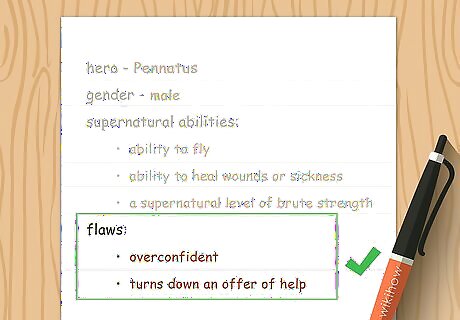
Add flaws to your hero. For the sake of a good story, the hero should make mistakes sometimes. Here are some flaws you could choose from, that would cause this to happen: The hero is overconfident, and ignores advice or turns down an offer of help. The hero is greedy or lustful, and tries to steal or take something that doesn't belong to her. The hero is arrogant, and thinks he's better than everyone else, or even better than the gods.

Brainstorm magical ideas. Witches, gods, monsters, magical items, and imaginary places all make a myth entertaining and larger than life. You could set your myth in ancient Greece, and use characters like Hades or the Chimera, or you can invent your own. If you're out of ideas, try reading collections of actual myths, or modern books that use mythological characters. Percy Jackson and the Olympians is a good example
Writing the Myth
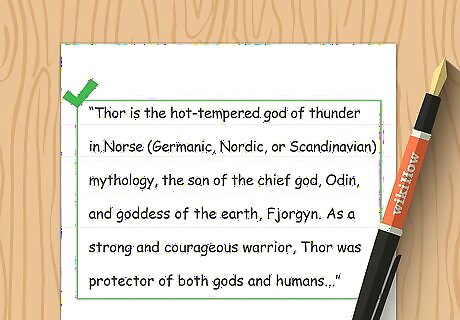
Write in simple, straightforward language. Myths tell a story directly, as though it were relating fact. Avoid long, wandering sentences and detailed descriptions. Don't include your own, personal opinion, and present everything as fact. This tends to make the plot move pretty quickly. In one version of the Herakles myth, the hydra is introduced, tracked down, and killed in just eight sentences.
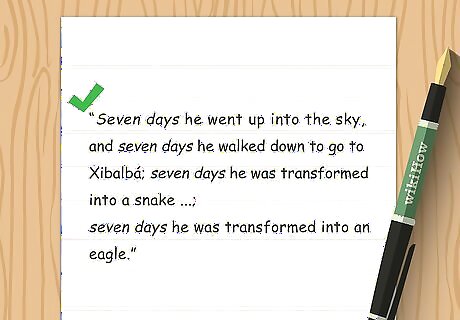
Write in mythological style. This is easiest to do by imitating the style of real myths, but you can easily use these following writing tricks to make your myth sound traditional: Use iconic symbols. These vary between traditions, but often include the numbers 3 and 7, animals like the raven or the seal, or characters like the prince or the trapped faerie. Use the same structure for several sentences in a row. For example: "Seven days he went up into the sky, and seven days he walked down to go to Xibalbá; seven days he was transformed into a snake ...; seven days he was transformed into an eagle." Give people a short, descriptive epithet. This is especially popular in Greek epics, which often use epithets that refer to other stories, such as "Dionysus the wolf-repeller" or "Apollo, carrier of the bay branches."
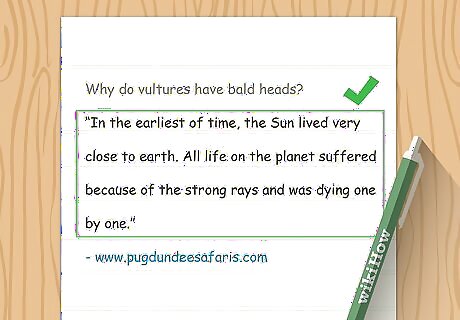
Introduce the setting and main character. People usually know they're listening to a myth even before the first couple sentences are finished. Here are some ways you can accomplish this: Set the myth in the distant past, or a distant land. Think of all the stories you know that begin "Once upon a time," "Far, far away," or even "A long, long time ago." Describe the kind of hero people expect in myths. For instance, a youngest brother, a king, or a woodcutter are all common heroes in folk tales. For more epic myths, start with a famous hero or a goddess instead.
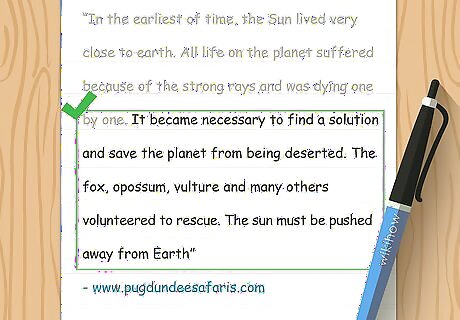
Create a reason for the main character to do something. You could start out describing the point of your story, explaining for instance that Coyote decided to steal fire to give to people. It's a more interesting story, however, if the character has a reason for behaving the way he does. Here are a few examples: Coyote notices people shivering in winter, and they plead for a way to warm themselves. A queen ignores her suffering subjects. The gods send a plague to her daughter, and the queen must learn to help people in exchange for their assistance to cure her daughter.
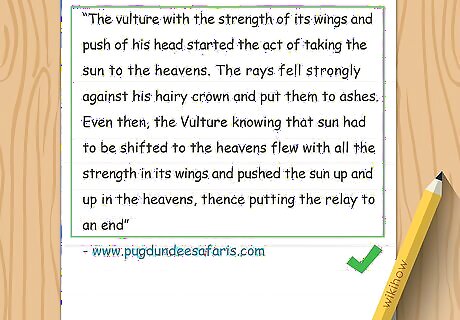
Continue the story. The middle of the myth is up to you, and there are no rules you have to follow. Keep writing the story, keeping in mind the phenomenon or moral lesson you're trying to explain. If you get stuck, move the story along with one of the following: Introduce a new character. This can be a god, a spirit, a talking animal, or an elder. The character might describe the next challenge to come and how to overcome it, or give the hero a magical item that he can use later. Create a new challenge. Just when everything is looking good again, have the hero make a mistake, or send a monster to undo the hero's good work. This is useful if you want the story to go on longer.

Finish the myth. Continue writing until you've finished your explanation, or until the hero has defeated all the challenges and learned her lesson. Often, a myth ends with a sentence explaining why the story is related to the present day. Here are some invented examples: "And that's why the sun gets hotter and bright every summer." "And ever since then, people brush their teeth to a shine every night, so the tooth-stealing goblins are scared by their own hideous reflection."

Read it aloud while editing. Once you think your myth is almost finished, read it aloud to yourself or to a friend. Some phrases might sound better on paper than they do out loud, and myths are usually written to be shared as a spoken story. Go through it and correct spelling and grammar mistakes as well, then have a friend take a second look in case you missed something.




















Comments
0 comment